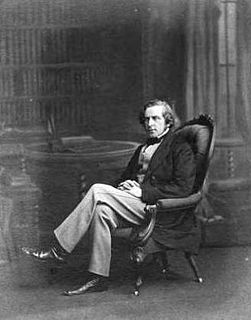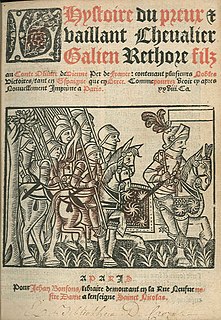
James Orchard Halliwell-Phillipps, born James Orchard Halliwell, was an English Shakespearean scholar, antiquarian, and a collector of English nursery rhymes and fairy tales.
The Proverbs of Alfred is a collection of early Middle English sayings ascribed to King Alfred the Great, said to have been uttered at an assembly in Seaford, East Sussex. The collection of proverbs was probably put together in Sussex in the mid-12th century. The manuscript evidence suggests the text originated at either a Cluniac or Benedictine monastery, either Lewes Priory, 10 mi (16 km) to the north of Seaford, or Battle Abbey, 25 mi (40 km) to the north-east.
Thomas Chestre was the author of a 14th-century Middle English romance Sir Launfal, a verse romance of 1045 lines based ultimately on Marie de France's Breton lay Lanval. He was possibly also the author of the 2200-line Libeaus Desconus, a story of Sir Gawain's son Gingalain based upon similar traditions to those that inspired Renaut de Beaujeu's late-12th-century or early-13th-century Old French romance Le Bel Inconnu, and also possibly of a Middle English retelling of the mid-13th-century Old French romance Octavian. Geoffrey Chaucer parodied Libeaus Desconus, among other Middle English romances, in his Canterbury Tale of Sir Thopas.
Layamon's Brut, also known as The Chronicle of Britain, is a Middle English poem compiled and recast by the English priest Layamon. The Brut is 16,096 lines long and narrates the history of Britain: it is the first historiography written in English since the Anglo-Saxon Chronicle. Named for Britain's mythical founder, Brutus of Troy, the poem is largely based on the Anglo-Norman Roman de Brut by Wace, which is in turn a version of Geoffrey of Monmouth's Latin Historia Regum Britanniae. Layamon's poem, however, is longer than both and includes an enlarged section on the life and exploits of King Arthur. It is written in the alliterative verse style commonly used in Middle English poetry by rhyming chroniclers, the two halves of the alliterative lines being often linked by rhyme as well as by alliteration.
The South English Legendary is a Middle English hagiographic work, best preserved in MS Harley 2277 and CCCC 145, which contain 92 narrative lives, extremely varied in length, usually including one of two prologues and often including a life of Christ and/or temporal items. The collection also includes lives of "anti-saints" Judas and Pilate.
Korean New Zealanders, also referred to informally as Korean Kiwis or Kowis, are New Zealand citizens and residents of Korean ancestry. The 2006 New Zealand census found 30,792 Koreans in the country, virtually all from South Korea, making them the third-largest Asian population there, and more than 0.75 per cent of the total population of New Zealand.
The Eneados is a translation into Middle Scots of the Latin Virgil's Aeneid, completed by the poet and clergyman Gavin Douglas in 1513.

Galiens li Restorés, or Galien le Restoré or Galien rhétoré, is an Old French chanson de geste which borrows heavily from chivalric romance. Its composition dates anywhere from the end of the twelfth century to the middle of the fourteenth century. Five versions of the tale are extant, dating from the fifteenth century to the sixteenth century, one in verse and the others in prose. The story—which is closely linked to the earlier chansons de gestePèlerinage de Charlemagne and The Song of Roland —tells of the adventures of Galien, son of the hero Olivier and of Jacqueline, the daughter of the (fictional) emperor Hugon of Constantinople.
Robert Thornton was a Yorkshire landowner, a member of the landed gentry. His efforts as an amateur scribe and manuscript compiler resulted in the preservation of many valuable works of Middle English literature, and have given him an important place in its history.

Octavian is a 14th-century Middle English verse translation and abridgement of a mid-13th century Old French romance of the same name. This Middle English version exists in three manuscript copies and in two separate compositions, one of which may have been written by the 14th-century poet Thomas Chestre who also composed Libeaus Desconus and Sir Launfal. The other two copies are not by Chestre and preserve a version of the poem in regular twelve-line tail rhyme stanzas, a verse structure that was popular in the 14th century in England. Both poetic compositions condense the Old French romance to about 1800 lines, a third of its original length, and relate “incidents and motifs common in legend, romance and chanson de geste.” The story describes a trauma that unfolds in the household of Octavian, later the Roman Emperor Augustus, whose own mother deceives him into sending his wife and his two newborn sons into exile and likely death. After many adventures, the family are at last reunited and the guilty mother-in-law appropriately punished.

The Anglo-Norman romance Ipomedon by Hue de Rotelande, composed near Hereford around 1180, survives in three separate Middle English versions, a long poem Ipomadon composed in tail-rhyme verse, possibly in the last decade of the fourteenth century, a shorter poem The Lyfe of Ipomydon, dating to the fifteenth century and a prose version, Ipomedon, also of the fifteenth century. In each case, the story is taken independently from the Anglo-Norman romance Ipomedon, written in Old French by Hue de Rotelande "not long after 1180", possibly in Herefordshire, England. It is included in a list of the popular English romances by Richard Hyrde in the 1520s.
Ywain and Gawain is an early-fourteenth century Middle English Arthurian verse romance based quite closely upon the late-twelfth century Old French romance The Knight of the Lion by Chrétien de Troyes.
The Erl of Toulouse is a medieval English chivalric romance centered on an innocent persecuted wife. It is supposed to be a translated lai, but the original lai is lost. It is thought to date from the late 14th century, and survives in four manuscripts of the 15th and 16th centuries. The Erl of Toulouse is written in a north-east Midland dialect of Middle English.
Sir Degrevant is a Middle English romance from the early fifteenth century. Generally classified as a "composite romance," that is, a romance that does not fit easily into the standard classification of romances, it is praised for its realism and plot. The poem is preserved in two manuscripts along with a variety of secular and courtly texts, one of which was compiled by the fifteenth-century scribe Robert Thornton. It is notable for its blending of literary material and social reality.
An Irish Astronomical Tract, medieval Irish text and manuscript.
The StanzaicMorte Arthur is an anonymous 14th-century Middle English poem in 3,969 lines, about the adulterous affair between Lancelot and Guinevere, and Lancelot's tragic dissension with King Arthur. The poem is usually called the Stanzaic Morte Arthur or Stanzaic Morte to distinguish it from another Middle English poem, the Alliterative Morte Arthure. It exercised enough influence on Thomas Malory's Le Morte d'Arthur to have, in the words of one recent scholar, "played a decisive though largely unacknowledged role in the way succeeding generations have read the Arthurian legend".

Beves of Hamtoun, also known as Beves of Hampton, Bevis of Hampton or Sir Beues of Hamtoun, is an anonymous Middle English romance of 4620 lines, dating from around the year 1300, which relates the adventures of the English hero Beves in his own country and in the Near East. It is often classified as a Matter of England romance. It is a paraphrase or loose translation of the Anglo-Norman romance Boeuve de Haumton, and belongs to a large family of romances in many languages, including Welsh, Russian and even Yiddish versions, all dealing with the same hero.
Þjalar-Jóns saga, also known as Saga Jóns Svipdagssonar ok Eireks forvitna is a medieval Icelandic saga defined variously as a romance-saga and a legendary saga. The earliest manuscript, Holm. perg. 6 4to, dates from around the first quarter of the fifteenth century, and the saga is thought to be from the fourteenth century.
E-Theses Online Service (EThOS) is a bibliographic database and union catalogue of electronic theses provided by the British Library, the National Library of the United Kingdom. As of March 2018 EThOS provides access to approximately 480,000 doctoral theses awarded by over 140 UK higher education institutions, with around 3000 new thesis records added every month.
A. S. G. Edwards is Professor of Medieval Manuscripts at the University of Kent. Having studied at the University of Reading and McMaster University, he earned his Ph.D. at the University of London. Edwards is the co-editor of the Index of Middle English Prose (IMEP), currently in its twenty-third volume. Edwards is the author of such works as Middle English Prose: a critical guide to major authors and genres and editor of A Companion to Middle English Prose and The Life of St Edmund, King & Martyr: John Lydgate's illustrated verse life presented to Henry VI. Edwards is also co-editor of the New Index of Middle English Verse (2005) and A Companion to Fifteenth-Century English Poetry, and co-editor with Vincent Gillespie and Ralph Hanna of The English Medieval Book: Studies in Memory of Jeremy Griffiths (2000). His research has been funded by the Guggenheim Foundation.






